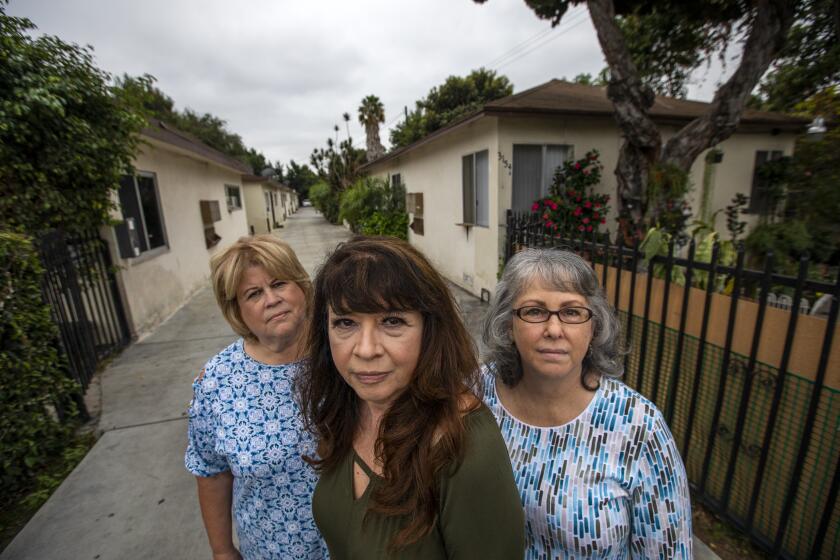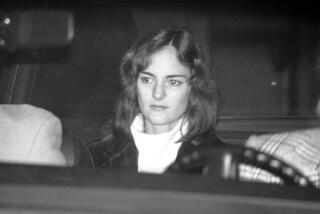Notorious ‘sweethearts’ killer dies in prison. Here’s what cracked the 1980 cold case

- Share via
For more than two decades, the slayings of two UC Davis students stumped law enforcement, until DNA evidence finally led investigators to the kidnapper and rapist behind the notorious “sweetheart murders.”
Now, after 11 years on San Quentin’s death row, Richard J. Hirschfield has died of natural causes, the California Department of Corrections and Rehabilitation announced.
His death puts a period on a long and grisly tale that haunted the families of Hirschfield’s victims for half a century.
The sweethearts, John Riggins and Sabrina Gonsalves, were 18-year-old freshmen at the Northern California school. On Dec. 20, 1980, they were volunteering at a production of “The Nutcracker” ballet at the Davis Community Center.
“These kids were exceptional, and I don’t take that word usage lightly,” said investigator Ron Garverick in a Sacramento County district attorney’s office podcast. “They really, truly were. Each of them was very involved in community, in family, in the school, in giving back.”
Solving a cold case is a daunting prospect for anyone, let alone amateurs. But three women are determined to find justice for a slain high school classmate.
The couple was abducted by Hirschfield after leaving the community center that evening.
Gonsalves’ sister Andrea reported Gonsalves missing the following day. She would wait 33 years to see the killer convicted.
Hirschfield raped Gonsalves and dumped both of the teenagers’ bodies in a ravine about 30 miles east of Davis in Sacramento County, where they were found by police three days later. Their throats had been slashed and their heads wrapped in duct tape.
“The Gonsalves family was headed by George, who was an Air Force colonel, very stoic man, strong family man,” said lead prosecutor Dawn Bladet in the podcast. “Andrea described how she had never seen her father cry until they had gotten the news of Sabrina’s death, and he dropped to his knees and was wailing about his baby.”
Investigators struggled for almost a decade to identify a culprit. Then in 1989, David Hunt and Doug Lainer were arrested as suspects in Yolo County.
Hunt was the half-brother of Gerald Gallego, a Sacramento-area serial killer who raped and killed at least 11 women. Investigators theorized that Hunt had developed the same sadistic taste.
The suspects sat in prison for three years waiting for their trial in Yolo County Superior Court. Before that could happen, investigators made a breakthrough in the case when they discovered a previously overlooked stain on a blanket that turned out to be semen.
Neither suspect was a match for the DNA, and they were both released. The case went cold again.
That was, until police uploaded the semen sample to a national DNA database in 2001. There was an immediate match to a sex offender listed in Washington state. There, Hirschfield was in jail for fondling two young girls.
Investigators quickly discovered he had been convicted of another violent sexual crime in California five years before slaying the sweethearts.
In 1975, Hirschfield broke into the Mountain View apartment of two sisters, ages 16 and 22.
“He threatened them, tied them up, had a box cutter, garrote. He had a gun in his hand. He asked who wanted to be raped,” Bladet said. The 22-year-old “didn’t want her little sister to be raped, so she said, ‘Please don’t hurt her, take me,’ and he did.”
Investigators now had a clear link to their suspect, but securing an arrest and verdict was no simple feat.
“All the 1980 original investigative materials had to be looked at and documented and then, of course, all the new investigations,” Bladet said. “In the end, there was over 200,000 pages, 80 banker boxes of materials in this case.”
Not all of the original evidence had been well preserved, and much of it had to be shipped down to Sacramento from Yolo County, where the initial investigation against Hunt and Lainer had taken place. Multiple witnesses had died since the crime took place, and many struggled to recount the long-ago events, the prosecutor said.
Then there was the matter of the suicide note left by Hirschfield’s brother Joseph, who killed himself shortly after police announced that a DNA match had been found in the sweetheart murders.
In the note, Joseph wrote, “Richard did commit those murders, but I was there. I didn’t kill anyone but my DNA is still there.”
The note was both a blessing and a curse, Bladet said, as it sparked a fierce debate between prosecutors and defense over whether any parts of the note could be used as evidence.
A federal judge sentenced Anna Rene Moore to 90 months in prison, a harsher sentence than that requested by the government and a federal public defender.
“There’s a difference between what we know happened and what we can prove in court, what is admissible evidence,” Bladet said. “There was no way that Joseph’s dying declaration about Richard being guilty was going to come into evidence. The law doesn’t allow it, so we had to take those parts of the note out.”
The note also created the opportunity for the defense team to try to pin the murders on Joseph, she said.
Finally, in 2013, more than 10 years after crime-scene DNA was matched to Hirschfield, the jury reached a verdict. Hirschfield was found guilty on two counts of first-degree murder and use of a firearm with an enhancement of use of a deadly weapon. He was committed to San Quentin’s death row.
“I felt so relieved for these families, and they were just full of emotion, extremely relieved,” Bladet said. “It had been such a long time coming for them. They had lived with this for 30 years.”
Hirschfield died Monday at California Medical Facility, a prison hospital in Vacaville, at 75 years old.
The sweethearts he murdered, Riggins and Gonsalves, have a tree and plaque dedicated to them on UC Davis’ campus.
More to Read
Sign up for Essential California
The most important California stories and recommendations in your inbox every morning.
You may occasionally receive promotional content from the Los Angeles Times.












